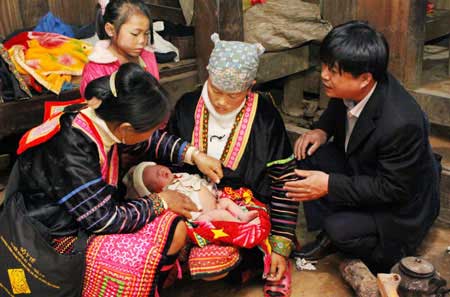Rural midwives rewarded with pay rise
Published: 27/04/2013 03:08
The role of village midwives in the country's health system will officially be recognised when the Ministry of Health's circular 07/2013/TT-BYT comes into effect at the beginning of next month.
With the recognition, village midwives, including those working in ethnic groups and remote areas, will be entitled to regular allowances from the State budget. "The circular encourages village-based ethnic group midwives to provide maternal and child health care in remote and mountainous areas where women usually give birth at home," said Tien. The circular also regulated that the village midwives must complete the MoH's courses, which take at least six months, work under the professional management of commune medical stations and be supervised by the commune people's committee. Mandeep O'Brien, UNFPA representative in Viet Nam, said the circular showed the strong commitment and great effort of the Government in achieving the health-related Millennium Development Goals by improving human resources for healthcare at the grass-roots level. If ethnic minority midwives were empowered to provide the health-care services they were trained for, the nation would not only save many lives, but would also improve its economic and social productivity, she said. Speaking to Viet Nam News over the phone on Tuesday, April 23, Deputy director of northern mountainous Ha Giang Province's Department of Health Dang Van Huynh also commended the Government's action. Vietnamnet |
Provide by Vietnam Travel
Rural midwives rewarded with pay rise - Social - News | vietnam travel company
You can see more
- Belarusian Culture Days set for May 23-29 in Hanoi
- Plan for Dong Van geopark development approved
- Beginning first river bus route in Ho Chi Minh City in June
- Vietnam set to become a MICE ‘tiger’ of Southeast Asia
- Many students in Japan are in danger after snowslide
- Automated street parking piloted in Hanoi
- USAID supports Vietnam to fight wildlife smuggling
- Summer camp for overseas Vietnamese youth
enews & updates
Sign up to receive breaking news as well as receive other site updates!
- Hanoi ranked top 3 cuisine in the world in 2023
- Beautiful resorts for a weekend escape close to Hanoi
- Travel trends in 2023
- In the spring, Moc Chau is covered in plum blossoms.
- The Most Wonderful Destinations In Sapa
- Top 3 Special festivals in Vietnam during Tet holiday - 2023
- 5 tourist hotspots expected to see a spike in visitors during Lunar New Year 2023
- How To Make Kitchen Cleaned
- Health benefits of lime
- Cooperation expanding between Havard University and Vietnamese universities
-
vietnam travel
http://www.vietnamtourism.org.vn " Vietnam Tourism: Vietnam Travel Guide, Culture, Travel, Entertainment, Guide, News, and...
-
Vietnam culture, culture travel
http://travel.org.vn " Vietnam culture
-
Vietnam travel, vietnam travel news, vietnam in photos
http://www.nccorp.vn " Vietnam travel, vietnam travel news, vietnam in photos
-
Vietnam tourism
http://www.vietnamtourism.org.vn " The official online information on culture, travel, entertainment, and including facts, maps,...
-
Vietnam Travel and Tourism
http://www.vietnamtourism.org.vn/ " Vietnam Travel, Entertainment, People, Agents, Company, Vietnam Tourism information.
-
Information travel online
http://www.travellive.org "Information travel online













